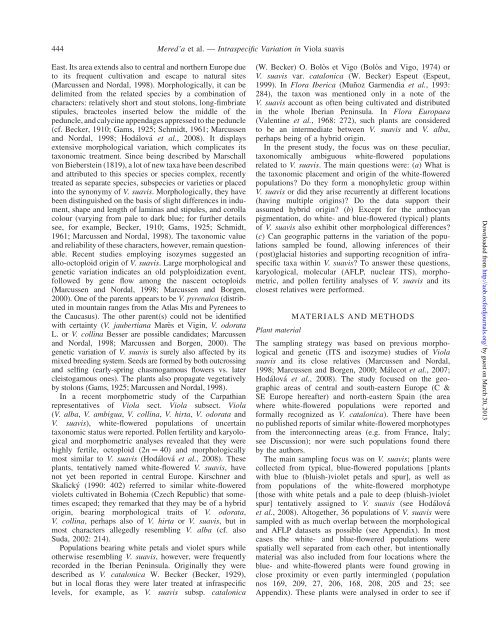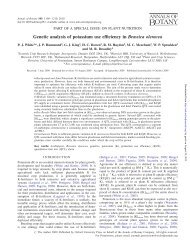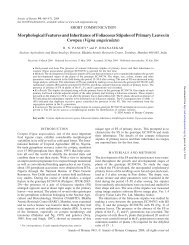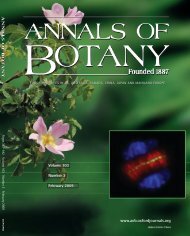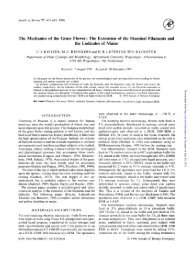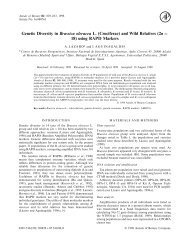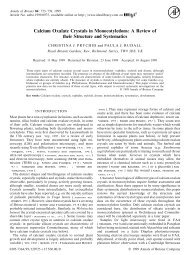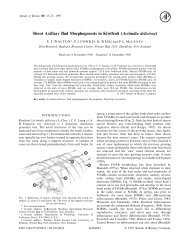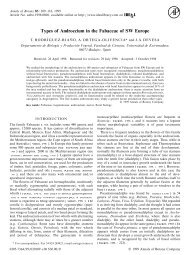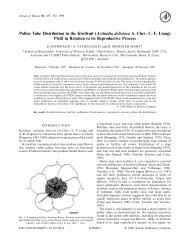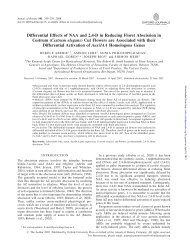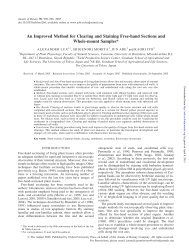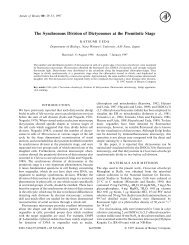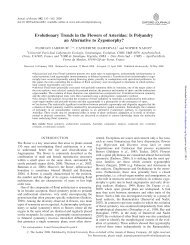Intraspecific Variation in Viola suavis in Europe ... - Annals of Botany
Intraspecific Variation in Viola suavis in Europe ... - Annals of Botany
Intraspecific Variation in Viola suavis in Europe ... - Annals of Botany
Create successful ePaper yourself
Turn your PDF publications into a flip-book with our unique Google optimized e-Paper software.
444<br />
East. Its area extends also to central and northern <strong>Europe</strong> due<br />
to its frequent cultivation and escape to natural sites<br />
(Marcussen and Nordal, 1998). Morphologically, it can be<br />
delimited from the related species by a comb<strong>in</strong>ation <strong>of</strong><br />
characters: relatively short and stout stolons, long-fimbriate<br />
stipules, bracteoles <strong>in</strong>serted below the middle <strong>of</strong> the<br />
peduncle, and calyc<strong>in</strong>e appendages appressed to the peduncle<br />
(cf. Becker, 1910; Gams, 1925; Schmidt, 1961; Marcussen<br />
and Nordal, 1998; Hodálová et al., 2008). It displays<br />
extensive morphological variation, which complicates its<br />
taxonomic treatment. S<strong>in</strong>ce be<strong>in</strong>g described by Marschall<br />
von Bieberste<strong>in</strong> (1819), a lot <strong>of</strong> new taxa have been described<br />
and attributed to this species or species complex, recently<br />
treated as separate species, subspecies or varieties or placed<br />
<strong>in</strong>to the synonymy <strong>of</strong> V. <strong>suavis</strong>. Morphologically, they have<br />
been dist<strong>in</strong>guished on the basis <strong>of</strong> slight differences <strong>in</strong> <strong>in</strong>dument,<br />
shape and length <strong>of</strong> lam<strong>in</strong>as and stipules, and corolla<br />
colour (vary<strong>in</strong>g from pale to dark blue; for further details<br />
see, for example, Becker, 1910; Gams, 1925; Schmidt,<br />
1961; Marcussen and Nordal, 1998). The taxonomic value<br />
and reliability <strong>of</strong> these characters, however, rema<strong>in</strong> questionable.<br />
Recent studies employ<strong>in</strong>g isozymes suggested an<br />
allo-octoploid orig<strong>in</strong> <strong>of</strong> V. <strong>suavis</strong>. Large morphological and<br />
genetic variation <strong>in</strong>dicates an old polyploidization event,<br />
followed by gene flow among the nascent octoploids<br />
(Marcussen and Nordal, 1998; Marcussen and Borgen,<br />
2000). One <strong>of</strong> the parents appears to be V. pyrenaica (distributed<br />
<strong>in</strong> mounta<strong>in</strong> ranges from the Atlas Mts and Pyrenees to<br />
the Caucasus). The other parent(s) could not be identified<br />
with certa<strong>in</strong>ty (V. jaubertiana Marès etVig<strong>in</strong>,V. odorata<br />
L. or V. coll<strong>in</strong>a Besser are possible candidates; Marcussen<br />
and Nordal, 1998; Marcussen and Borgen, 2000). The<br />
genetic variation <strong>of</strong> V. <strong>suavis</strong> is surely also affected by its<br />
mixed breed<strong>in</strong>g system. Seeds are formed by both outcross<strong>in</strong>g<br />
and self<strong>in</strong>g (early-spr<strong>in</strong>g chasmogamous flowers vs. later<br />
cleistogamous ones). The plants also propagate vegetatively<br />
by stolons (Gams, 1925; Marcussen and Nordal, 1998).<br />
In a recent morphometric study <strong>of</strong> the Carpathian<br />
representatives <strong>of</strong> <strong>Viola</strong> sect. <strong>Viola</strong> subsect. <strong>Viola</strong><br />
(V. alba, V. ambigua, V. coll<strong>in</strong>a, V. hirta, V. odorata and<br />
V. <strong>suavis</strong>), white-flowered populations <strong>of</strong> uncerta<strong>in</strong><br />
taxonomic status were reported. Pollen fertility and karyological<br />
and morphometric analyses revealed that they were<br />
highly fertile, octoploid (2n ¼ 40) and morphologically<br />
most similar to V. <strong>suavis</strong> (Hodálová et al., 2008). These<br />
plants, tentatively named white-flowered V. <strong>suavis</strong>, have<br />
not yet been reported <strong>in</strong> central <strong>Europe</strong>. Kirschner and<br />
Skalicky´ (1990: 402) referred to similar white-flowered<br />
violets cultivated <strong>in</strong> Bohemia (Czech Republic) that sometimes<br />
escaped; they remarked that they may be <strong>of</strong> a hybrid<br />
orig<strong>in</strong>, bear<strong>in</strong>g morphological traits <strong>of</strong> V. odorata,<br />
V. coll<strong>in</strong>a, perhaps also <strong>of</strong> V. hirta or V. <strong>suavis</strong>, but <strong>in</strong><br />
most characters allegedly resembl<strong>in</strong>g V. alba (cf. also<br />
Suda, 2002: 214).<br />
Populations bear<strong>in</strong>g white petals and violet spurs while<br />
otherwise resembl<strong>in</strong>g V. <strong>suavis</strong>, however, were frequently<br />
recorded <strong>in</strong> the Iberian Pen<strong>in</strong>sula. Orig<strong>in</strong>ally they were<br />
described as V. catalonica W. Becker (Becker, 1929),<br />
but <strong>in</strong> local floras they were later treated at <strong>in</strong>fraspecific<br />
levels, for example, as V. <strong>suavis</strong> subsp. catalonica<br />
Mered’a et al. — <strong>Intraspecific</strong> <strong>Variation</strong> <strong>in</strong> <strong>Viola</strong> <strong>suavis</strong><br />
(W. Becker) O. Bolòs et Vigo (Bolòs and Vigo, 1974) or<br />
V. <strong>suavis</strong> var. catalonica (W. Becker) Espeut (Espeut,<br />
1999). In Flora Iberica (Muñoz Garmendia et al., 1993:<br />
284), the taxon was mentioned only <strong>in</strong> a note <strong>of</strong> the<br />
V. <strong>suavis</strong> account as <strong>of</strong>ten be<strong>in</strong>g cultivated and distributed<br />
<strong>in</strong> the whole Iberian Pen<strong>in</strong>sula. In Flora Europaea<br />
(Valent<strong>in</strong>e et al., 1968: 272), such plants are considered<br />
to be an <strong>in</strong>termediate between V. <strong>suavis</strong> and V. alba,<br />
perhaps be<strong>in</strong>g <strong>of</strong> a hybrid orig<strong>in</strong>.<br />
In the present study, the focus was on these peculiar,<br />
taxonomically ambiguous white-flowered populations<br />
related to V. <strong>suavis</strong>. The ma<strong>in</strong> questions were: (a) What is<br />
the taxonomic placement and orig<strong>in</strong> <strong>of</strong> the white-flowered<br />
populations? Do they form a monophyletic group with<strong>in</strong><br />
V. <strong>suavis</strong> or did they arise recurrently at different locations<br />
(hav<strong>in</strong>g multiple orig<strong>in</strong>s)? Do the data support their<br />
assumed hybrid orig<strong>in</strong>? (b) Except for the anthocyan<br />
pigmentation, do white- and blue-flowered (typical) plants<br />
<strong>of</strong> V. <strong>suavis</strong> also exhibit other morphological differences?<br />
(c) Can geographic patterns <strong>in</strong> the variation <strong>of</strong> the populations<br />
sampled be found, allow<strong>in</strong>g <strong>in</strong>ferences <strong>of</strong> their<br />
(post)glacial histories and support<strong>in</strong>g recognition <strong>of</strong> <strong>in</strong>fraspecific<br />
taxa with<strong>in</strong> V. <strong>suavis</strong>? To answer these questions,<br />
karyological, molecular (AFLP, nuclear ITS), morphometric,<br />
and pollen fertility analyses <strong>of</strong> V. <strong>suavis</strong> and its<br />
closest relatives were performed.<br />
MATERIALS AND METHODS<br />
Plant material<br />
The sampl<strong>in</strong>g strategy was based on previous morphological<br />
and genetic (ITS and isozyme) studies <strong>of</strong> <strong>Viola</strong><br />
<strong>suavis</strong> and its close relatives (Marcussen and Nordal,<br />
1998; Marcussen and Borgen, 2000; Málecot et al., 2007;<br />
Hodálová et al., 2008). The study focused on the geographic<br />
areas <strong>of</strong> central and south-eastern <strong>Europe</strong> (C &<br />
SE <strong>Europe</strong> hereafter) and north-eastern Spa<strong>in</strong> (the area<br />
where white-flowered populations were reported and<br />
formally recognized as V. catalonica). There have been<br />
no published reports <strong>of</strong> similar white-flowered morphotypes<br />
from the <strong>in</strong>terconnect<strong>in</strong>g areas (e.g. from France, Italy;<br />
see Discussion); nor were such populations found there<br />
by the authors.<br />
The ma<strong>in</strong> sampl<strong>in</strong>g focus was on V. <strong>suavis</strong>; plants were<br />
collected from typical, blue-flowered populations [plants<br />
with blue to (bluish-)violet petals and spur], as well as<br />
from populations <strong>of</strong> the white-flowered morphotype<br />
[those with white petals and a pale to deep (bluish-)violet<br />
spur] tentatively assigned to V. <strong>suavis</strong> (see Hodálová<br />
et al., 2008). Altogether, 36 populations <strong>of</strong> V. <strong>suavis</strong> were<br />
sampled with as much overlap between the morphological<br />
and AFLP datasets as possible (see Appendix). In most<br />
cases the white- and blue-flowered populations were<br />
spatially well separated from each other, but <strong>in</strong>tentionally<br />
material was also <strong>in</strong>cluded from four locations where the<br />
blue- and white-flowered plants were found grow<strong>in</strong>g <strong>in</strong><br />
close proximity or even partly <strong>in</strong>term<strong>in</strong>gled (population<br />
nos 169, 209, 27, 206, 168, 208, 205 and 25; see<br />
Appendix). These plants were analysed <strong>in</strong> order to see if<br />
Downloaded from<br />
http://aob.oxfordjournals.org/ by guest on March 20, 2013


